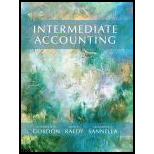
Intermediate Accounting
1st Edition
ISBN: 9780132162302
Author: Elizabeth A. Gordon, Jana S. Raedy, Alexander J. Sannella
Publisher: PEARSON
expand_more
expand_more
format_list_bulleted
Textbook Question
Chapter 7, Problem 7.3Q
If interest is compounded more than once a year, will the effective interest rate be higher than the annual stated interest rate? Explain.
Expert Solution & Answer
Want to see the full answer?
Check out a sample textbook solution
Students have asked these similar questions
Its gross margin ratio? General accounting
Its gross margin ratio?
How much Mary include in her gross income in year 1 ?
Chapter 7 Solutions
Intermediate Accounting
Ch. 7 - Prob. 7.1QCh. 7 - Prob. 7.2QCh. 7 - If interest is compounded more than once a year,...Ch. 7 - Prob. 7.4QCh. 7 - Can an ordinary annuity table be used to determine...Ch. 7 - Prob. 7.6QCh. 7 - Is the present value of an ordinary annuity more...Ch. 7 - Prob. 7.8QCh. 7 - Simple Interest. Assume Shafer Corporation...Ch. 7 - Compound Interest. Assume Shafer Corporation...
Ch. 7 - Prob. 7.3BECh. 7 - Prob. 7.4BECh. 7 - Prob. 7.5BECh. 7 - Present Value of a Single Sum, Compound Interest....Ch. 7 - Future Value of a Single Sum, Compound Interest....Ch. 7 - Prob. 7.8BECh. 7 - Present Value of a Single Sum, Compounded Interest...Ch. 7 - Prob. 7.10BECh. 7 - Present Value of a Single Sum, Calculating Time...Ch. 7 - Future Value of an Ordinary Annuity. An...Ch. 7 - Future Value of an Annuity Due. Mariah Carey...Ch. 7 - Future Value of an Ordinary Annuity: Calculating...Ch. 7 - Present Value of an Ordinary Annuity. CB...Ch. 7 - Present Value of an Annuity Due, Semiannual...Ch. 7 - Prob. 7.17BECh. 7 - Ordinary Annuity, Annuity Due, Using Interest...Ch. 7 - Prob. 7.2ECh. 7 - Prob. 7.3ECh. 7 - Prob. 7.4ECh. 7 - Prob. 7.5ECh. 7 - Prob. 7.6ECh. 7 - Prob. 7.7ECh. 7 - Future Value of an Ordinary Annuity, Future Value...Ch. 7 - Single Sum, Solving for Other Variables. Two...Ch. 7 - Ordinary Annuity, Solve for Interest Rate,...Ch. 7 - Present Value, Note Payable Prices. Wiz Khalifa...Ch. 7 - Future Value of a Deterred Annuity. Lenny Shafer...Ch. 7 - Prob. 7.13ECh. 7 - Present Value of an Ordinary Annuity, Present...Ch. 7 - Prob. 7.15ECh. 7 - Prob. 7.16ECh. 7 - Future Value of an Annuity Due, Decision Making....Ch. 7 - Prob. 7.18ECh. 7 - Prob. 7.19ECh. 7 - Prob. 7.20ECh. 7 - Prob. 7.21ECh. 7 - Prob. 7.22ECh. 7 - Prob. 7.1PCh. 7 - Present Value, Present Value of an Ordinary...Ch. 7 - Present Value, Present Value of an Annuity Due,...Ch. 7 - Prob. 7.4PCh. 7 - Prob. 7.5PCh. 7 - Prob. 7.6PCh. 7 - Prob. 7.7PCh. 7 - Present Value of an Annuity Due, Deferred...Ch. 7 - Present Value of an Ordinary Annuity, Present...Ch. 7 - Future Value of an Ordinary Annuity, Deferred...Ch. 7 - Present Value, Present Value of an Ordinary...Ch. 7 - Prob. 7.12PCh. 7 - Prob. 7.13PCh. 7 - Expected Cash Flows. Hiteck Electronics sells a...Ch. 7 - Prob. 7.15P
Additional Business Textbook Solutions
Find more solutions based on key concepts
(Compound interest uith nonannnal periods)
Calculate the future sum of $5,000, given that it will be held in th...
Foundations Of Finance
Opportunity cost of capital Which of the following statements are true? The opportunity cost of capital:
Equals...
PRIN.OF CORPORATE FINANCE
11-9. Identify a company with a product that interests you. Consider ways the company could use customer relati...
Business Essentials (12th Edition) (What's New in Intro to Business)
The net present value of a project. Introduction: The difference between the present value of cash outflow and ...
Corporate Finance (4th Edition) (Pearson Series in Finance) - Standalone book
Quick ratio (Learning Objective 7) 510 min. Calculate the quick assets and the quick ratio for each of the foll...
Financial Accounting, Student Value Edition (5th Edition)
Comparison of projects using Net Present Value. Reasons for the conflicts in ranking using Net Present Value an...
Gitman: Principl Manageri Finance_15 (15th Edition) (What's New in Finance)
Knowledge Booster
Learn more about
Need a deep-dive on the concept behind this application? Look no further. Learn more about this topic, accounting and related others by exploring similar questions and additional content below.Similar questions
arrow_back_ios
SEE MORE QUESTIONS
arrow_forward_ios
Recommended textbooks for you

 EBK CONTEMPORARY FINANCIAL MANAGEMENTFinanceISBN:9781337514835Author:MOYERPublisher:CENGAGE LEARNING - CONSIGNMENTPrinciples of Accounting Volume 2AccountingISBN:9781947172609Author:OpenStaxPublisher:OpenStax College
EBK CONTEMPORARY FINANCIAL MANAGEMENTFinanceISBN:9781337514835Author:MOYERPublisher:CENGAGE LEARNING - CONSIGNMENTPrinciples of Accounting Volume 2AccountingISBN:9781947172609Author:OpenStaxPublisher:OpenStax College


EBK CONTEMPORARY FINANCIAL MANAGEMENT
Finance
ISBN:9781337514835
Author:MOYER
Publisher:CENGAGE LEARNING - CONSIGNMENT

Principles of Accounting Volume 2
Accounting
ISBN:9781947172609
Author:OpenStax
Publisher:OpenStax College
What Does ROI (Return On Investment) Really Mean?; Author: REtipster;https://www.youtube.com/watch?v=Z6ThJvNr1Dw;License: Standard Youtube License